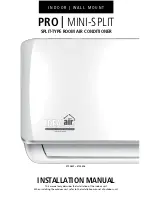
31 Rev. 3
SYSTEM OPERATION
The indoor evaporator coil functions to cool and dehumidify
the air conditioned spaces through the evaporative process
taking place within the coil tubes.
NOTE: The pressures and temperatures shown are for dem-
onstration purposes only. Actual temperatures and pres-
sures are to be obtained from the "Cooling Performance
Chart."
Liquid refrigerant at condensing temperature and pressure,
(120°F and 270 psig), leaves the outdoor condensing coil
through the drier and is metered into the indoor coil through
the metering device. As the cool, low pressure, saturated
refrigerant enters the tubes of the indoor coil, a portion of the
liquid immediately vaporizes. It continues to soak up heat
and vaporizes as it proceeds through the coil, cooling the
indoor coil down to a temperature of 48°F.
Heat is continually being transferred to the cool fins and tubes
of the indoor evaporator coil by the warm system air. This
warming process causes the refrigerant to boil. The heat
removed from the air is carried off by the vapor.
As the vapor passes through the last tubes of the coil, it
becomes superheated, that is, it absorbs more heat than is
necessary to vaporize it. This is assurance that only dry gas
will reach the compressor. Liquid reaching the compressor
can weaken or break compressor valves.
The compressor increases the pressure of the gas, thus add-
ing more heat, and discharges hot, high pressure superheated
gas into the outdoor condenser coil.
In the condenser coil, the hot refrigerant gas, being warmer
than the outdoor air, first loses its superheat by heat trans-
ferred from the gas through the tubes and fins of the coil. The
refrigerant now becomes saturated, part liquid, part vapor and
then continues to give up heat until it condenses to a liquid
alone. Once the vapor is fully liquefied, it continues to give
up heat which subcools the liquid, and it is ready to repeat
the cycle.
COOLING CYCLE
The condensing unit is used in conjunction with an air han-
dling device such as a blower coil assembly or coil and fur-
nace, and is controlled electrically by a room thermostat.
When the contacts of the room thermostat close making ter-
minals R to Y and G, the low voltage circuit of the trans-
former is completed. A current now flows through the holding
coils of the compressor contactor and fan relay.
This draws in the normally open contact CC
1
which is wired
in series with the motors in the line voltage circuit, starting
the compressor and condenser fan motors. At the same time
the thermostat energizes a fan relay which starts the fan
motor of the remotely located evaporator unit.
When the thermostat is satisfied, its contacts open, break-
ing the low voltage circuit. This causes the compressor con-
tactor and indoor fan relay to open, shutting down the sys-
tem.
If the room thermostat fan selector switch should be set on
the "ON" position then the indoor blower would run continu-
ous rather than cycling with the compressor.
HEATING CYCLE
When a remote condensing unit and evaporator coil are used
in conjunction with a gas, oil, or electric furnace; consult the
manufacturers installation and service instructions for opera-
tion and proper room thermostat heat anticipator setting.
If using a Blower Cabinet for heating only, a single stage
heating thermostat would be required. For heating and cool-
ing a standard single stage heat and single stage cooling
thermostat may be used.
When using a blower coil with optional field installed electric
heat, and the thermostat calls for heat. Terminals R to W2
close, completing the low voltage (24V) circuit of the trans-
former. Current now flows through the first stage heater time
delay relay coil. After a predetermined time, the main set of
contacts close, energizing the 4.8KW heating element. Con-
nected in parallel with the heating element is the heating fan
relay coil (240V) whose contacts will also close starting the
indoor blower motor. An auxiliary set of contacts within the
Time Delay Relay will now close completing the circuit (24V)
to the second stage time delay relay coil. After a predeter-
mined time the main contacts of the second time delay relay
will close energizing the second 4.8KW heating element.
If additional 4.8KW heaters are field installed, they would be
energized in the same sequence.
Provisions are made at the low voltage connection board so
that outdoor temperature controls may also be field installed.
These in turn would limit the number of heaters which could
cycle in relation to the outdoor temperature settings. Con-
sult the Specification Section, Wiring Diagrams, etc. for the
maximum number of heating elements that may be installed,
proper motor speeds for air requirements and room thermo-
stat heat anticipator settings.
BBA Standard Efficiency Blower Section
Sequence of Operation
BBA Cooling-Only Operations
The cooling operation is fairly straight forward. With the ther-
mostat in the FAN—AUTO position and a “Y” or “G” call, the
blower starts within three seconds. When the “Y” call is sat-
isfied, the blower will stay on until the supply temperature is
greater than 65°F or up to a maximum of forty-five seconds,
whichever occurs first.
Note: BBA blower units require a jumper between the "Y"
and "O" terminals for non heat pump cooling operation.
















































